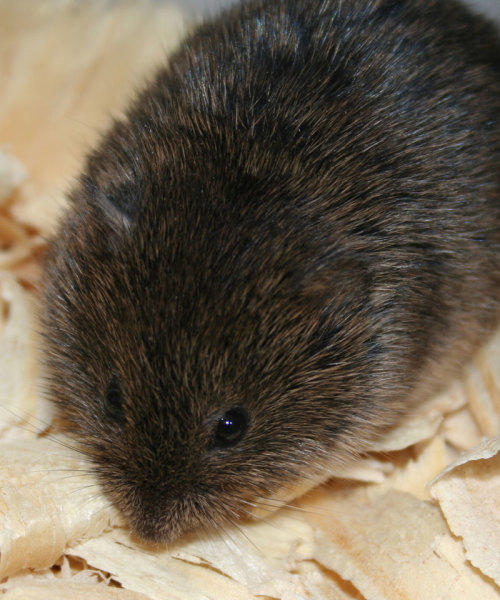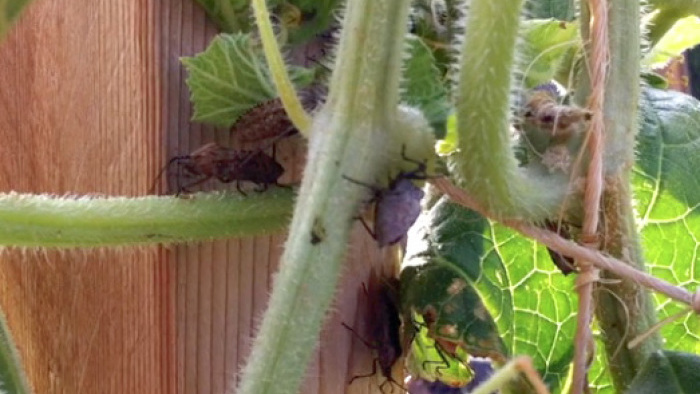
If you’re interested in controlling voles, chances are you’ve already learned about their eating habits. Quietly spending most of their time out of sight, voles commonly come to our attention when damaged bark is found at the base of valued fruit trees and ornamental plants.
A mouse with small ears, the vole is Mickey Mouse’s country cousin. But voles, Microtus spp., are strictly outdoor mice. They are small and chunky with short legs and tail. Unlike Disney’s creation inspired by the house mouse, voles have small ears, partially hidden by their fur. Usually they are brown or gray, but there may be a variation on the belly of white, yellow, or cinnamon. Many species are found from one end of the country to the other. If two vole species overlap geographically, they generally separate out by habitat. Some like it drier or wetter, some are excellent swimmers, some can climb well, but all are attracted to areas with vegetation that provides protection.
These little rodents are part of complex food webs in all areas where they exist naturally. Owls, hawks, snakes, coyotes, weasels, even domestic cats, prey on them. In one study, it was found that 88% of the population died during the first month of life. Overall, the life span of a vole is short, probably 16 months at most, but during that time it has a remarkable ability to multiply. A vole can have five litters of three to six young in a year.
They’re cute until they damage special plantings. Voles like to nibble on the bark of fruit trees and ornamental plants. The transfer of nutrients and water between a plant’s roots and leaves occurs just beneath the bark surface. Bark nibbling interferes with this vital life support system and if extensive, can eventually kill the plant. This is most likely to be a problem in fall and winter when voles’ other food sources are scarce. They usually eat grasses and weeds, but they also relish insects like gypsy moths, snails, and the remains of dead animals. In the fall, they gather and store seeds, bulbs, tubers, and rhizomes.
Voles are active day and night, all year round. Although they can carry a number of disease organisms transmissible to humans, they are usually not a public health hazard because we rarely encounter them in the wild. It is when they move into orchards, gardens, or other human-designed and managed systems that there is a potential for problems.
Distinguishing vole damage from rabbit damage. Even though you see girdling of trees, or gnaw marks on bark, it does not necessarily mean the damage is due to voles. Other animals like rabbits can cause similar problems. The difference is in the size and uniformity of the gnaw marks. Vole marks occur at different angles and in irregular patches. One expert describes them as 1⁄8 in. wide, 3⁄8 in. long, and 1⁄6 in. or more deep. In contrast, rabbit gnaw marks are larger and not as distinct. Rabbits clip off small branches with clean oblique cuts. Voles nibble.
If chewing damage makes you suspect voles, the next thing to look for is their pathway system on the ground surface, where the voles have worn down grass and weeds. Pathways are 1 in. to 2 in. wide and can be quite extensive with numerous burrow openings. One species of vole, the pine vole, builds only underground tunnels. It favors forests, abandoned fields, and orchards.
Manage habitat to discourage voles. Now that you know something about their lifestyle, you can probably guess the best way to manage voles when they’re causing trouble. Reduce the cover they need to protect themselves from predators—the key point is that voles don’t like to feed in the open. Cut down grass and other high vegetation. Pull mulch back 2 ft. to 3 ft. from the base of trees and shrubs. Leave the ground bare. Until the situation is under control, you may even need to remove mulch from garden beds.
Ploughing or tilling the soil is effective in destroying the voles’ pathway and burrow systems. This is why voles are often less of a problem with annual crops, unless plants form a dense vegetative cover for a long period of time. If vole damage is severe in a home orchard, you can destroy their burrows with a rototiller by turning the soil under 5 in. to 6 in.
Place collars around the base of trunks of small trees and shrubs. You can use heavy wire such as hardware cloth. One-quarter-inch mesh is necessary to prevent voles from biting through. Or try cutting the top and bottom off a heavy plastic bottle and slit the side so that it will fit around the tree. In any case, barriers must extend into the soil at least 6 in. and rise above it 8 in. to 12 in. Check the barriers a couple of times a year to make sure they’re not restricting plant growth. You may need to stake the barriers if the soil is loose, or if you’re not able to sink them as deeply into the soil as you would like.
Since most species of voles are poor climbers, it may be worthwhile to place a 1⁄4-in. hardware cloth fence around a garden bed you are trying to protect. The fence should extend at least 1 ft. above and 10 in. below the ground. Stake the fence at intervals to be sure it remains upright. Since vole populations fluctuate, extreme efforts like fencing might be necessary some years, but not others.
If other strategies don’t work, trapping the critters is an option. Voles can be caught with mouse snap traps baited with a paste of rolled oats and peanut butter. Here is some advice on trapping provided by Robert H. Schmidt, Department of Fisheries and Wildlife, Utah State University, Logan, UT: Set the traps on the ground, perpendicular to the vole pathway with the trigger end in the pathway. A pinch of rolled oats sprinkled in the pathway next to the traps may entice the voles, but be careful not to disturb the pathways or burrows. Make sure that traps are level and don’t wobble. You don’t want voles to be frightened away by movement, and you want the traps to perform properly so they’ll catch instantly, killing the vole.
Birds may also be tempted by the oats. To prevent them from getting caught, cover traps with a length of cardboard bent in half. Leave enough space above the trap so the cardboard doesn’t prevent the trap from springing.
Most importantly, don’t skimp on the number of traps. For a small garden, start with a dozen. For a large garden or orchard, you may need 50 traps or more. Also, it’s essential to keep vegetation suppressed while you’re trapping to deny cover to the voles.
Wear gloves when handling the captured voles. Or, you can put your hand inside a plastic bag and use it as a glove to release the dead vole from the trap. Secure the bag with a twist tie and dispose of it in the garbage. The most important thing to remember when trapping any rodent is to be persistent. If the vole population is large, it may take a while to make a difference.
by Sheila Daar
December 1997
from issue #12
Fine Gardening Recommended Products

Ho-Mi Digger - Korean Triangle Blade
Fine Gardening receives a commission for items purchased through links on this site, including Amazon Associates and other affiliate advertising programs.

A.M. Leonard Deluxe Soil Knife & Leather Sheath Combo
Fine Gardening receives a commission for items purchased through links on this site, including Amazon Associates and other affiliate advertising programs.

Corona High Performance Orchard Loppers
Fine Gardening receives a commission for items purchased through links on this site, including Amazon Associates and other affiliate advertising programs.


















Comments
Log in or create an account to post a comment.
Sign up Log in